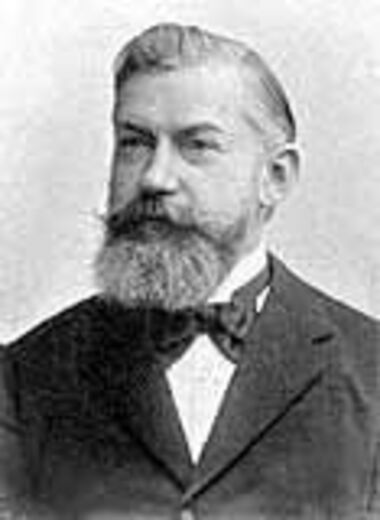History of Urology in Heidelberg

As have all other specialties in Heidelberg, Urology has contributed significantly to medical progress. Indeed, in the 19th century operative Urology in Heidelberg was already legendary. Examples of outstanding surgical accomplishments follow:
- first kidney removal (nephrectomy) by Gustav Simon in 1869
- first tumor nephrectomy (Vinzenz von Czerny, 1882)
- first partial nephrectomy (Vinzenz von Czerny, 1883)
- radical prostatectomy for prostate cancer (Vinzenz von Czerny, 1893)
- perineal radical prostatectomy (Martin Kirschner, b. 1879 – d. 1942).
This distinguished history has continued. Max Wilms (1867 – 1918), an early twentieth-century Chair, was the first to describe nephroblastoma in children, the entity that now bears his name (Wilms’ tumor). Modern imaging techniques of the urinary tract with contrast media were pioneered by Friedrich Voelcker (1872–1955) and Alexander von Lichtenberg (1880–1949). In 1967 the first kidney transplantation in Germany was carried out by Lars Roehl, and in 1991 Staehler and Beer performed the first laparoscopic lymphadenectomy for prostate cancer in Europe.
Clinical Spectrum
The Department of Urology of the Heidelberg University Medical Center addresses all the contemporary clinical challenges: urologic oncology, reconstructive surgery, pediatric urology, lower urinary tract dysfunction, and stone disease. The faculty are recognized experts in their subspecialties, yet they value the personal approach. The nursing staff, likewise, is highly competent and empathetic.
To meet the present-day needs of its patients, the Department is equipped with the latest technology:
- daVinci® surgical systems (computer-assisted 3D imaging during laparoscopic surgery of adrenal glands, kidney, bladder, and prostate)
- Intraoperative irradiation (targeted combination therapy of locally advanced tumors)
- Neodym:YAG laser (surgery of tumors of bladder, urethra, and external genitalia)
- Heart-lung machine (treatment of kidney malignancies with tumor thrombus extending to the right side of the heart)
- Argon-Plasma Coagulation (kidney-preserving surgery of renal tumors, tumors extending into the surrounding muscle tissues)
- Ultracision/harmonic scalpel® (preparation and hemostasis of soft tissue)
- Operating microscope (micro-reconstructive surgery)
- KTP Greenlight laser (laser ablation of benign prostatic hyperplasia)
- Holmium laser (endoscopic stone removal)
- Digitalized video-urodynamics (diagnosis of lower urinary tract dysfunction in children and adults)
As a result, we treat approximately 16,000 patients annually. Nevertheless, each patient is recognized as an individual with unique problems and needs.
The Cooperating Oncologic Group/Urology
The success of the Department has also been made possible by a refined approach to patient care. Based on its own long experience and that of other internationally respected institutions, treatment in urologic oncology has been integrated within a comprehensive cancer center (National Center for Tumor Disease - NCT). A combined strategic effort of all specialties involved in diagnosis, therapy, and after-care of urologic malignancies has defined common standard operating procedures (SOPs) for every urological tumor. Participating departments are Urology, Diagnostic Radiology, Radiotherapy, Clinical Oncology, and Pediatric Oncology. Additionally, the German Cancer Research Institution (DKFZ) is part of the team, designated the Cooperating Oncologic Group (COG) / Urology.
Every cancer patient can rely on the expertise and competence of all team members of the COG/Urology to receive the best possible therapy for his or her disease, whether surgery, radiotherapy, chemotherapy, or a combination. This integrated therapeutic concept promotes the potential cure of many tumors with an underlying pathology that may be complex and challenging. The coordination of diagnosis and treatment of patients with urological malignancies is provided by the Department of Urology, University of Heidelberg Medical School.
Financial Terms
The philosophy of our Department is to care for our patients in the best possible manner. To do so must include responsible economic terms as well. Thus, patients from outside Germany and overseas are welcomed, and are not charged any additional premium for seeking treatment here. Consequently, they are subjected to the same sound financial conditions, which are set by the German public and private health insurance system.
The City of Heidelberg
In addition to the renowned quality of care in Heidelberg, the city itself is a wonderful place to visit. From the terraces of the mystic Heidelberg Castle, one may marvel at the Neckar river coursing through the mountains of the Odenwald into the valley of the Rhine, on whose banks the medieval architecture of the Old City can be viewed intact. For accommodations, one may choose a traditional inn or guesthouse, some of which are nearly 1000 years old, or one of our excellent hotels.
Sightseeing, shopping, dining -- you will be welcomed by the friendly, multilingual population of Heidelberg, who extend their well known hospitality without regard to season. Our administrative staff will be happy to help you and those accompanying you plan a memorable stay.